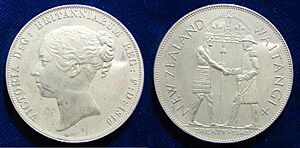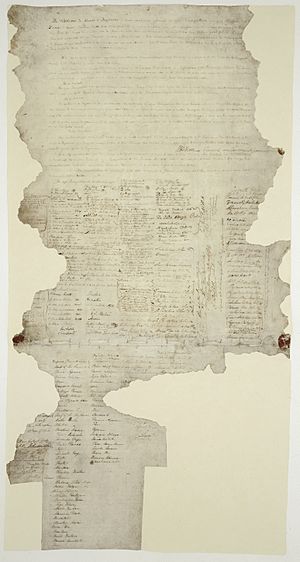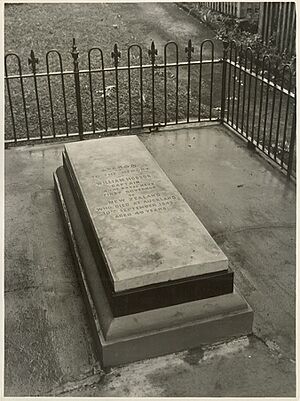William Hobson facts for kids
Quick facts for kids
William Hobson
|
|
|---|---|
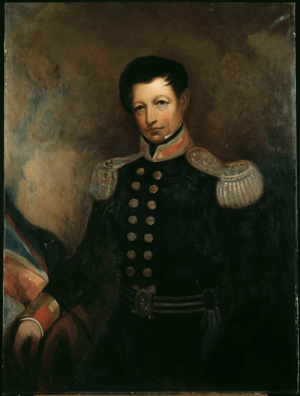 |
|
| 1st Governor of New Zealand | |
| In office 3 May 1841 – 10 September 1842 |
|
| Monarch | Victoria |
| Preceded by | Office established |
| Succeeded by | Robert FitzRoy |
| Lieutenant-Governor of New Zealand | |
| In office 30 July 1839 – 3 May 1841 |
|
| Monarch | Victoria |
| Governor | George Gipps (Governor of New South Wales) |
| Preceded by | Office established |
| Succeeded by | Office abolished |
| Personal details | |
| Born | 26 September 1792 Waterford, Ireland |
| Died | 10 September 1842 (aged 49) Auckland, New Zealand |
| Resting place | Symonds Street Cemetery |
| Spouse | Eliza Elliott |
| Children | 5 |
| Military career | |
| Allegiance | |
| Branch | |
| Service years | 1803–1842 |
| Rank | Captain |
| Commands held |
|
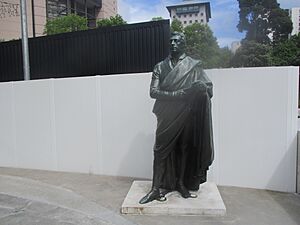
Captain William Hobson (born 26 September 1792 – died 10 September 1842) was an Irish officer in the British Royal Navy. He became the first Governor of New Zealand. He also helped write the Treaty of Waitangi, a very important agreement in New Zealand's history.
Hobson was sent from London in July 1839. His job was to set up a British colony in New Zealand. He first became Lieutenant-Governor in Sydney, Australia. He arrived in New Zealand on 29 January 1840.
On 5 February 1840, Hobson met with Māori chiefs at Waitangi. The next day, they signed a treaty. This treaty meant the chiefs agreed to give control of their land to the British Crown. In return, they were promised protection for their lands and rights as British subjects. A few months later, Hobson announced that New Zealand was now under British rule. He also chose a place for a new capital, which he named Auckland.
In May 1841, New Zealand became its own Crown colony, separate from New South Wales. Hobson was promoted to Governor. He faced health problems in his last months. He died in September 1842 while still in office.
Contents
William Hobson was born in Waterford, Ireland. He joined the Royal Navy on 25 August 1803 when he was just 10 years old. He served during the Napoleonic Wars. These were major conflicts between France and other European powers.
Later, he helped stop piracy in the Caribbean. Pirates were sea robbers who attacked ships. Hobson became known as "Lion Hobson" because he captured several pirate ships. He was promoted to commander in 1824.
Exploring Australia
In 1836, Hobson was sent to Australia. He arrived in Hobart and then Sydney. His ship, HMS Rattlesnake, helped explore Port Phillip. This area later became Melbourne.
During this time, Hobson and his team carefully mapped the area. A part of Port Phillip was named Hobsons Bay after him. His ship also helped establish the port of Williamstown.
Becoming Governor of New Zealand
On 26 May 1837, Hobson sailed to the Bay of Islands in New Zealand. He went there because the British Resident, James Busby, needed help. There were conflicts between Māori tribes. When Hobson returned to England in 1838, he suggested that Britain should take control of parts of New Zealand.
Lieutenant-Governor Role
At this time, the British government respected the independence of the Māori people. This was stated in the Declaration of the Independence of New Zealand from 1835. Hobson was appointed as Lieutenant-Governor under the Governor of New South Wales, Sir George Gipps. This appointment was made on 30 July 1839.
Hobson received detailed instructions on 14 August 1839. These instructions explained why Britain wanted to get involved in New Zealand. They also told him to buy land fairly from the Māori. This land would then be sold to European settlers.
Hobson arrived in the Bay of Islands on 29 January 1840. He brought a small group of officials with him. These officials helped him set up the new government.
The Treaty of Waitangi
The Treaty of Waitangi was a very important agreement. Hobson had first suggested it when he returned to Britain. When he arrived in New Zealand, he quickly wrote the treaty with his secretary and James Busby. Busby had also written the Declaration of Independence.
Hobson was the main British person to sign the treaty. The Ngāpuhi chief Hōne Heke was the first Māori chief to sign. As each chief signed, Hobson said, "He iwi tahi tātou." This means "We are [now] one people." To make the treaty stronger, eight more copies were made. These copies were sent around the country to get more signatures from other chiefs.
After signing the treaty at the Bay of Islands on 6 February 1840, Hobson traveled. He went to Waitematā Harbour to get more signatures. He also looked for a good place for the new capital city. He suffered a stroke on 1 March 1840. He was taken back to the Bay of Islands to recover.
On 21 May 1840, Hobson announced that Britain now had control over all of New Zealand. He did this even though not all chiefs had signed the treaty yet. He sent officials to Port Nicholson (now Wellington) to stop a group of settlers who were trying to set up their own government. Their leader, William Wakefield, later agreed to follow the British Crown. Hobson chose Waitematā Harbour for the new capital. He named it Auckland after the Earl of Auckland.
In July 1840, a French ship arrived in the Bay of Islands. It was on its way to Banks Peninsula as part of a French settlement plan. Hobson quickly sent officials to Akaroa to show that Britain claimed control there. Towards the end of 1840, settlers in Port Nicholson complained about Hobson to Queen Victoria. Hobson replied to these complaints in May 1841.
Governor of New Zealand
In November 1840, Queen Victoria signed a special document. This made New Zealand a Crown Colony, separate from New South Wales. Hobson officially became the Governor of New Zealand on 3 May 1841. On the same day, the General Legislative Council was formed. Hobson was in charge of choosing its members.
Hobson visited Wellington in August 1841. He listened to the settlers' complaints and chose new magistrates. He also visited Akaroa to deal with the French claims. Back in Auckland, he faced some challenges with the Māori people. Journalists in Wellington and Auckland also criticized his government. Hobson responded by closing down a newspaper. His government was low on money.
Hobson suffered a second stroke and died on 10 September 1842. He was buried in the Symonds Street Cemetery in Auckland.
Legacy
Several places in New Zealand are named after William Hobson:
- Hobsonville: This area was once considered a possible site for the New Zealand government.
- Hobson Bay
- Mount Hobson, Auckland
- Hobson Hill: A small hill near Waitangi, Northland.


